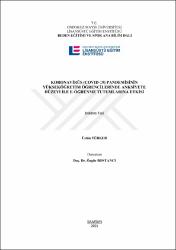| dc.contributor.advisor | Bostancı, Özgür | |
| dc.contributor.author | Türker, Üstün | |
| dc.date.accessioned | 2023-04-14T07:59:34Z | |
| dc.date.available | 2023-04-14T07:59:34Z | |
| dc.date.issued | 2021 | en_US |
| dc.date.submitted | 2021 | |
| dc.identifier.citation | Üstün, T. (2021). Koronavirüs (COVID-19) pandemisinin yükseköğretim öğrencilerinde anksiyete düzeyi ile e-öğrenme tutumlarına etkisi. (Doktora tezi). Ondokuz Mayıs Üniversitesi, Samsun. | en_US |
| dc.identifier.uri | https://hdl.handle.net/20.500.12712/33967 | |
| dc.description | Tam Metin / Tez | en_US |
| dc.description.abstract | COVID-19 (SARS-CoV-2) pandemisinde dünyadaki üniversitelerin birçoğu
bireysel ve kitlesel izolasyon için eğitim-öğretim faaliyetlerinde zorunlu bir dijital
dönüşüm gerçekleştirmiş olup, salgın hastalığın öğrencilerde anksiyete bozukluğuna
sebep olup/olmadığı merak konusudur. Bu bilgiler ışığında araştırmamızın amacı, spor
bilimlerindeki yükseköğretim öğrencilerinin COVID-19 pandemisindeki anksiyete
düzeylerinin belirlenmesi ve E-Öğrenme tutumlarına etkisinin incelenmesidir.
Çalışmamız, nicel araştırma yöntemlerinden genel ve ilişkisel tarama tekniğiyle
desenlenmiştir. Araştırmanın çalışma grubunu 2020-2021 güz ve bahar dönemlerinde
öğrenimlerine lisans düzeyinde devam eden 2479 öğrenci oluşturdu. Verilerin
toplanmasında Demografik Bilgi Formu, Evren ve ark. (2020) tarafından Türkçe’ye
uyarlanan ‘Koronavirüs Anksiyete Ölçeği (KAÖ)’ (Lee, 2020) ve Biçer (2019)
tarafından Türkçe’ye adaptasyonu gerçekleştirilen ‘E-Öğrenmeye Yönelik Tutum
Ölçeği (EYTÖ)’ (Kisanga, 2016) kullanıldı. Veriler Google Formlar aracılığıyla dijital
ortamda toplandı ve analizlerinde Histogram Q-Q Plot, Tanımlayıcılar, Bağımsız Ttest ve Tek Yönlü Varyans (ANOVA) testleri uygulandı.
Öğrencilerin %26,3’ünde anksiyete oluşmuştur ve en yüksek semptom uyku
problemidir. Anksiyetesi bulunmayanların memnuniyet ve motivasyon tutumları daha
yüksek olsa da, anksiyetelilerin normal bireylere göre kullanışlılık tutumu ve teknoloji
kullanma eğilimi daha yüksek, EYTÖ toplam puanı da anlamlı ve yüksek düzeydedir
(p< ,05). Cinsiyete göre anksiyete ortalamaları benzer olsa da, E-Öğrenme tutumu kız
öğrencilerde yüksek bulunmuştur. Öğrencilerin yaş düzeyi yükseldikçe, anksiyete
bozukluğu da artmaktadır (p>,05). Antrenörlük Eğitimi öğrencilerinin anksiyete
düzeyi diğer bölümlere göre yüksektir (p<,05) ve EYTÖ puanı en yüksek Spor
Yöneticiliği öğrencileridir. Sınıf kademesi yükseldikçe, öğrencilerin anksiyetesi de
artış göstermektedir. Şahsi bilgisayarı olmayan, kısıtlı internet erişimine sahip ve
elektronik cihazları kullanma becerilerinde kendilerini yetersiz bulan öğrencilerin
anksiyetesi yüksek bulundu (p<,05). Pandemide düzenli olarak fiziksel egzersizlerine
devam edenlerin anksiyetesi, egzersiz yapmayanlara göre düşük ve EYTÖ puanlarının
yüksek olduğu sonucuna ulaşılmıştır (p<,001). Gelecekte benzer süreçlerin tekrar
yaşanabileceği ön görülerek, üniversiteler uzaktan eğitim faaliyetlerini iyileştirmeye
yönelik çalışmalara önem vermeli, ayrıca düzenli egzersizin anksiyete üzerindeki
pozitif etkisi düşünüldüğünde ilgili devlet kurumları toplumda fiziksel aktiviteyi
yaygınlaştırmaya yönelik spor politikaları geliştirmelidir. | en_US |
| dc.description.tableofcontents | During the COVID-19 (SARS-CoV-2) pandemic, many universities in the world
turned to digital platforms for educational activities because of individual and mass
isolation, and it is a subject of curiosity whether the infectious disease caused anxiety
in students. In light of this information, the aim of the study is to identify the anxiety
levels of higher education students in sports sciences during the COVID-19 pandemic
and examine its effect on their attitudes towards E-Learning.
Our study has been designed with general and correlational survey models,
which is one of the quantitative research methods. The sample of the study consists of
2479 students studying at the undergraduate level during the 2020-2021 fall and spring
semesters. For data collection, Demographic Information Form, ‘Coronavirus Anxiety
Scale (CAS)’, (Lee, 2020a),' which is adapted to Turkish by Evren et al. (2020), and
‘Test of E-Learning Related Attitudes Scale (TELRA)’ (Kisanga, 2016), which is
adapted to Turkish by Bicer (2019), have been used. The data were collected digitally
via Google Forms, and Histogram Q-Q Plot, Identifiers, Independent T-test, and One
Way ANOVA tests have been used for data analysis.
In the study, 26.3% of the students developed anxiety and the most common
symptom was sleep problems (CAS). Although the satisfaction and motivation
attitudes of those who did not develop anxiety were found to be higher, those who
developed anxiety had a higher usefulness attitude and tendency to use technology
compared to the normal individuals and had significantly higher total scores from
TELRA (p<.05). Although the anxiety means were similar by gender, the E-Learning
attitude was found to be higher in female students. As the age level of the students
increased, the anxiety disorder increased as well (p>.05). The anxiety levels of
Coaching students were higher than those of students from other departments (p<.05),
and the highest TELRA scores were from Sports Management students. As the grade
level increased, the anxiety levels of the students increased as well. The anxiety levels
of the students who did not have a personal computer, had limited access to an internet
connection, and found themselves inadequate in using electronic devices were found
to be high (p<.05). The anxiety levels of those who continued their regular physical
exercises were found to be lower than those who did not exercise and their TELRA
scores were found to be higher (p<.001). Considering that similar events may happen
again in the future, universities should prioritize improving distance learning activities,
and, considering the positive effect of regular exercise on anxiety, relevant government
organizations should develop sports policies towards extending physical activities in
society. | en_US |
| dc.language.iso | tur | en_US |
| dc.publisher | Ondokuz Mayıs Üniversitesi Lisansüstü Eğitim Enstitüsü | en_US |
| dc.rights | info:eu-repo/semantics/openAccess | en_US |
| dc.subject | anksiyete | en_US |
| dc.subject | e-öğrenme | en_US |
| dc.subject | tutum | en_US |
| dc.subject | COVID-19 | en_US |
| dc.subject | anxiety | en_US |
| dc.subject | e-learning | en_US |
| dc.subject | attitude | en_US |
| dc.subject | COVID-19 | en_US |
| dc.title | Koronavirüs (COVID-19) pandemisinin yükseköğretim öğrencilerinde anksiyete düzeyi ile e-öğrenme tutumlarına etkisi | en_US |
| dc.title.alternative | The effect of coronavirus (Covid-19) pandemic on anxiety levels and attitudes towards e-learning of higher education students | en_US |
| dc.type | doctoralThesis | en_US |
| dc.contributor.department | OMÜ, Lisansüstü Eğitim Enstitüsü, Beden Eğitimi ve Spor Ana Bilim Dalı | en_US |
| dc.contributor.authorID | 0000-0003-0604-8577 | en_US |
| dc.contributor.authorID | 0000-0002-7952-1014 | en_US |
| dc.relation.publicationcategory | Tez | en_US |
















